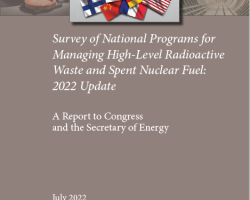Category of Content
Siting Experience Documents Only
Publication Date
Subject Matter
Keywords
Repository Layout and Required Ventilation Trade Studies in Clay-Shale using the DSEF Thermal Analytical Mode
Repository Layout and Required Ventilation Trade Studies in Clay-Shale using the DSEF Thermal Analytical Mode
Deep Borehole Field Test: Characterization Borehole Science Objectives
Deep Borehole Field Test: Characterization Borehole Science Objectives
Cavern/Vault Disposal Concepts and Thermal Calculations for Direct Disposal of 37- PWR Size: DPCs
Cavern/Vault Disposal Concepts and Thermal Calculations for Direct Disposal of 37- PWR Size: DPCs
Verification and Validation Strategy for Implementation of Hybrid Potts-Phase Field Hydride Modeling Capability in MBM
Verification and Validation Strategy for Implementation of Hybrid Potts-Phase Field Hydride Modeling Capability in MBM
Investigations of Dual-Purpose Canister Direct Disposal Feasibility (FY14)
Investigations of Dual-Purpose Canister Direct Disposal Feasibility (FY14)
Deep Borehole Field Test Specifications
Deep Borehole Field Test Specifications
Effects of Radial Hydrides on PWR Cladding Ductility following Drying and Storage
Effects of Radial Hydrides on PWR Cladding Ductility following Drying and Storage
Review of Underground Construction Methods and Opening Stability for Repositories in Clay/Shale Media
Review of Underground Construction Methods and Opening Stability for Repositories in Clay/Shale Media
Review of Underground Construction Methods and Opening Stability for Repositories in Clay Shale Media
Review of Underground Construction Methods and Opening Stability for Repositories in Clay Shale Media
Preliminary Destructive Examination Results for Sibling Pin Cladding
Preliminary Destructive Examination Results for Sibling Pin Cladding
REPOSITORY NEAR-FIELD THERMAL MODELING UPDATE INCLUDING ANALYSIS OF OPEN MODE DESIGN CONCEPTS, Draft Rev M
REPOSITORY NEAR-FIELD THERMAL MODELING UPDATE INCLUDING ANALYSIS OF OPEN MODE DESIGN CONCEPTS, Draft Rev M
REPOSITORY NEAR-FIELD THERMAL MODELING UPDATE INCLUDING ANALYSIS OF OPEN MODE DESIGN CONCEPTS
REPOSITORY NEAR-FIELD THERMAL MODELING UPDATE INCLUDING ANALYSIS OF OPEN MODE DESIGN CONCEPTS
Deep Borehole Disposal Research: Geological Data Evaluation, Alternative Waste Forms, and Borehole Seals
Deep Borehole Disposal Research: Geological Data Evaluation, Alternative Waste Forms, and Borehole Seals
Modeling Hydride Reorientation in Cladding
Modeling Hydride Reorientation in Cladding
Preliminary Destructive Examination Results for Sibling Pin Cladding
Preliminary Destructive Examination Results for Sibling Pin Cladding
A Salt Repository Concept for CSNF in 21-PWR Size Canisters
A Salt Repository Concept for CSNF in 21-PWR Size Canisters
A Salt Repository Concept for CSNF in 21-PWR Size Canisters, Rev 2
A Salt Repository Concept for CSNF in 21-PWR Size Canisters, Rev 2
Guidance for Creating a Community Benefits Plan for Regional Direct Air Capture Hubs
Guidance for Creating a Community Benefits Plan for Regional Direct Air Capture Hubs
This document is intended to provide supplemental information to assist applicants developing a Community Benefits Plan (CBP) for the Regional Direct Air Capture Hubs. As shown in the graphic to the right, Community Benefits Plans are based on a set of four core interdependent policy priorities: engaging communities and labor; investing in America's workforce; advancing diversity, equity, inclusion, and accessibility; and implementing Justice40.
Policies for Achieving Energy Justice in Society: Best Practices for Applying Solar Energy Technologies to Low-Income Housing
Policies for Achieving Energy Justice in Society: Best Practices for Applying Solar Energy Technologies to Low-Income Housing
Studies indicate that the energy burden — energy costs as a percentage of annual family income — on low-income families is inordinately high, compared to that of the rest of the population. Rising fuel costs exacerbate this problem. Residential solar energy systems can help address this situation by furnishing a price-stable energy source with the added benefit of reduced greenhouse gas emissions. However, without appropriate incentives, these systems are prohibitively expensive for low-income families.
Dose Rate Calculations for the 2-MCO/2-DHLW Waste Package
Dose Rate Calculations for the 2-MCO/2-DHLW Waste Package
WHF and RF Thermal Evaluation
WHF and RF Thermal Evaluation
Waste Package Neutron Absorber, Thermal Shunt, and Fill Gas Selection Report
Waste Package Neutron Absorber, Thermal Shunt, and Fill Gas Selection Report
Survey of National Programs for Managing High-Level Radioactive Waste and Spent Nuclear Fuel: 2022 Update
Survey of National Programs for Managing High-Level Radioactive Waste and Spent Nuclear Fuel: 2022 Update
In October 2009, the U.S. Nuclear Waste Technical Review Board (Board or NWTRB) published Survey of National Programs for Managing High-Level Radioactive Waste and Spent Nuclear Fuel. For each of the 13 national programs studied, the report catalogued 15 institutional arrangements that had been set in place and 15 technical approaches that had been taken to design repository systems for the long-term management of high-activity radioactive waste.

